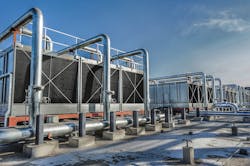Reduce Your Water Footprint Cost-Effectively: Three Tips for Data Centers
Cem Candir, CEO of Chemstar WATER, provides three tips for data centers looking for cost-effective ways to reduce their water footprint.
My previous article explored why we need water at data centers and how industry leaders manage this precious resource. Many readers asked a similar question: How can we reduce the water footprint and manage it cost-effectively?
Cem Candir, CEO of Chemstar WATER
According to the Department of Energy, in 2016, a 15 MW capacity data center consumed on average 100 million gallons of water annually—far more than what it is today. Based on our observations, strict water management programs and direct evaporative systems have reduced data center water consumption by 70%. Depending on the cooling system, location, and water quality, we estimate current consumption to be around 20-30 million gallons instead.
For now, water is the most cost-effective way to cool data centers. Data centers can utilize this cost-effective medium with virtually no environmental or community impact with well-established water management practices. Although the “water footprint” is complex, controlling and reducing water usage is quite simple.
(I) Monitor and Control Conductivity of Cooling System Sumps Religiously
Data center cooling systems use water evaporation to reject heat. The “blowdown”, unevaporated water, which is high in minerals (high conductivity), is flushed away and replaced with freshwater or water “make-up.”
Regardless of direct or indirect evaporative cooling systems, managing the cycle of concentration is critical and the most cost-effective solution. The cycle of concentration refers to the concentration of sold impurities in recirculating water. A high cycle saves water but creates scale build-up that may reduce cooling efficiency, adversely affecting the “power usage effectiveness” (PUE). A low cycle discharges blowdown prematurely, using more make-up water to compensate.
Each cooling system sump operates independently. Some data center campuses have hundreds of sumps. Monitoring and controlling each is the best approach to achieve the optimum cycles of concentration. The cost of monitoring and control is usually negligible compared to the water and energy savings. Data center operators can reduce their water use significantly with strict monitoring and control by themselves or by companies like Chemstar WATER.
(II) Trim Water Make-up Conductivity to Increase the Cycles of Concentrations
One way to reduce water’s scaling tendency is to attack the root cause of the problem. Water treatment equipment, such as reverse osmosis, electrodialysis reversal, or capacitive deionization, effectively reduces the mineral concentration in the water. Operators have hundreds of options to choose from.
Lower conductivity creates higher cycles of concentration with less water necessary to achieve the same cooling. I believe trimming conductivity is the most feasible method and the best opportunity to improve consumption. Using this method for one customer, Chemstar WATER reduced water consumption by 16 million gallons (~40%) annually.
(III) Recover the Blowdown
Depending on the region, water quality, water treatment, and type of system (equipment or chemical), the blowdown as a percentage to the make-up water can be as high as 67% of make-up water flow to as low as 5%.
Blowdown with high mineral concentration can be reused and re-utilized at data centers by removing the minerals through advanced water treatment equipment such as counter-flow reverse osmosis or cross-flow deionization. Another option is to reduce the concentration to a level compatible with other solutions.
Recovering blowdown is usually more expensive and less feasible compared to the first two water treatment options. However, recovered blowdown may be the most rewarding option from a water reuse standpoint.
As the data center operators trim their consumption substantially through the above points, there are also ways to go above and beyond and create net positive water by purchasing Water Restoration Credits (WRC). A recent example of this was demonstrated successfully by CyrusOne, who bought WRC from a non-profit called Bonneville Environmental Foundation (BEF). BEF provides the WRC partner with many organizations to channel funding from the sale of WRC to a range of projects that enhance or restore flows and water to benefit critically dewatered sections of rivers, streams, and wetlands. Several project types are used to achieve flow restoration goals.
The time is now to leverage existing technologies and solutions to trim and reuse our most precious resource while reducing the overall cost. With awareness, focus, and commitment, we can make an impact for today and tomorrow.
This article was submitted by Cem Candir, CEO of Chemstar WATER. Chemstar WATER proudly promotes smart water management and reuse as a solution to today’s data center usage needs.


